From about 1935 to 1940, Leland Knickerbocker and Paul Meyer worked for General Motors Art & Color Department helping to style locomotives made by GM subsidiary Electro-Motive Corporation. In 1941, when GM combined EMC and Winton Engines to form Electro-Motive Division, EMD created its own styling department. Over the next 40 years, this department employed several artists who designed color schemes and other aspects of GM locomotives.
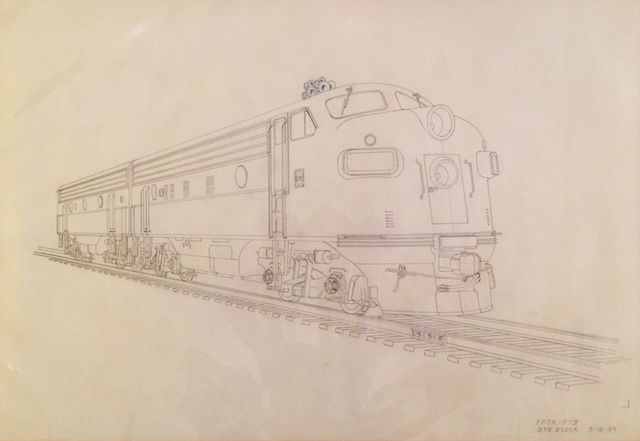
This drawing of an FP7 locomotive was done by Ben Dedek and is dated March 10, 1949. Such drawings were used as the “foundation” of artwork by Dedek and Bockewitz showing the locomotives in operation in each railroad’s paint scheme. Click image for a larger view of this drawing, which was provided by Greg Palumbo.
Among the first artists hired by EMD styling were Harry Urban Bockewitz and Benjamin John Dedek, who painted images of well over 100 GM locomotives between 1941 and the mid-1950s. Dedek was born in Chicago in 1895 and died in Clearwater, Florida in 1973; Bockewitz was born in Harvel, Illinois (south of Springfield) in 1897 and died in La Grange in 1982. Otherwise we have frustratingly little information about these two.
What we do know is that one of their names appeared on color portraits of most of the classes of locomotives GM produced between 1941 through the mid-1950s. These portraits were used, among other places, on data cards produced for each class of locomotives. These cards, which were about 7-1/2″ by 3-1/3″, were distributed by General Motors as a way to advertise their products. Some cards issued before mid-1941 are signed Paul A. Meyer, who worked for GM Art & Color. After mid-1941, Electro-Motive took over styling and for many years Dedek and Bockewitz did most of the color work.
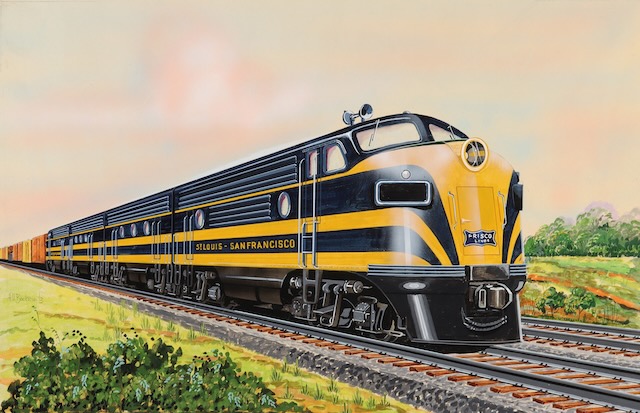
One of Harry Bockewitz’s proposals for a color scheme for Frisco F3 locomotives. Click image for a larger view. Source: Soulis.
Some information about Bockewitz and Dedek is provided by a nine-page paper written by Nick Zullo, one of the last artists to work for EMD styling. The paper lists 14 artists who worked for EMD styling and indicates that Zullo himself and two other artists continued to work for EMD after the styling department was closed and sometimes did paintings “as the need required.” Greg Palumbo has shared this paper with us and I hope Zullo doesn’t mind if I post it here.
Greg Palumbo also kindly provided me with scans of more than 100 locomotive data cards, which I’ll be presenting over the next several weeks. In addition, last year Soulis Auctions sold a collection of original artwork by Dedek and Bockewitz, and Dirk Soulis has graciously given me permission to present some of the images of those artworks here.
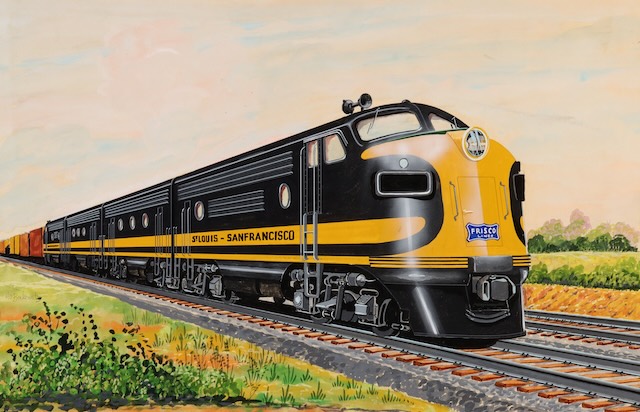
Another Bockewitz proposal for Frisco F3 locomotives. Click image for a larger view. Source: Soulis.
To develop a color scheme, the artists would first make a foundation drawing for each class of locomotive. For each railroad, they would then would then paint several “quickies” that showed alternative striping plans, with minimal additional detail. One goal was to make the locomotives visible at grade crossings, but another was to give each railroad its own distinctive style.
The artists tried to use colors from each railroad’s heritage but since most railroads at the time painted their locomotives black, their freight cars mineral red, and their passenger cars Pullman green, they usually had to be more creative. For regional railroads they sometimes used the colors of prominent universities on the rail line. For example, colors for Chicago & Eastern Illinois locomotives were orange and blue of the University of Illinois. Railroad executives would presumably approve of one of the plans and one of the artists would then make a detailed painting of the locomotive in that plan.
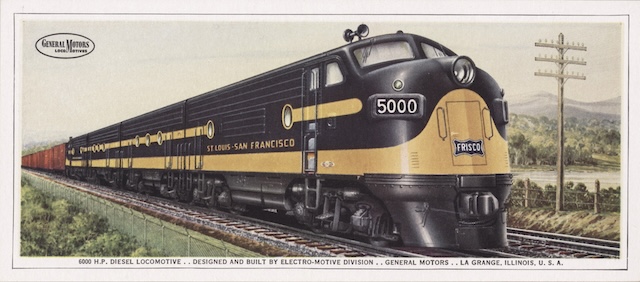
Dedek painted the final portrait for the color scheme that was selected for Frisco F3s. Click image to download a 1.1-MB PDF of this data card. Source: Palumbo.
The final paintings would be used in advertising, framable posters, and locomotive data cards. Sometimes the data cards were cropped so that the artist’s signature was not visible. However, a comparison of Dedek and Bockewitz’s work reveals that Dedek put a lot more detail in the landscaping around the locomotive. As Jim Boyd notes, “you could count the stones in the roadbed if Dedek did it and ever rivet showed on the third unit.” Perhaps this attention to detail explains why Derek tended to do most of the final paintings while Bockewitz and others did more of the quickies.
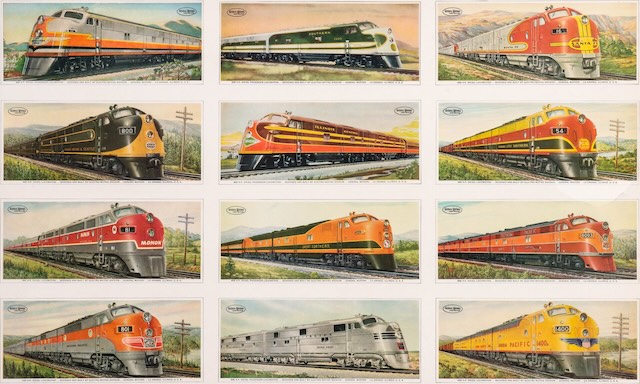
GM printed data cards in batches of 12. Click image for a larger view. Source: Soulis.
GM printed the data cards a dozen at a time and then cut them up, presumably distributing them to potential buyers of similar locomotives. The Soulis auction had a set of twelve, all of which were in the Palumbo collection so I’ll be presenting the individual cards in the next few weeks.
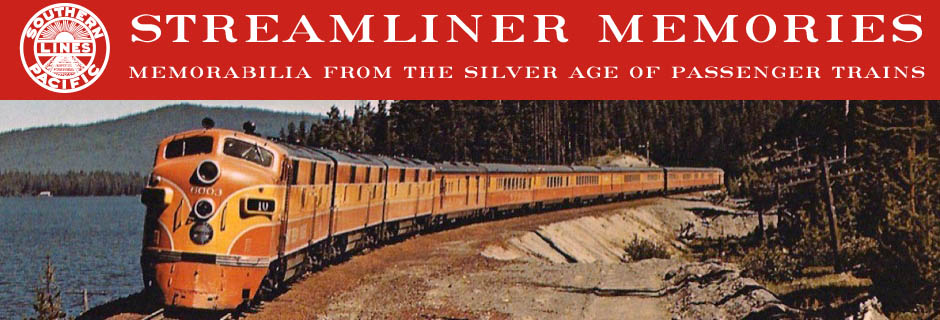
The SP Daylight scheme looked great, of course. IMO, the “Bloody Nose” that followed (along with the simulated stainless steel cars with red letter board) wasn’t all that bad, it’s just that they suffered by comparison with its predecessor.
Should add that if SP had kept the Lark two-tone gray and paired it with the gray and red locomotives that would’ve looked OK too.